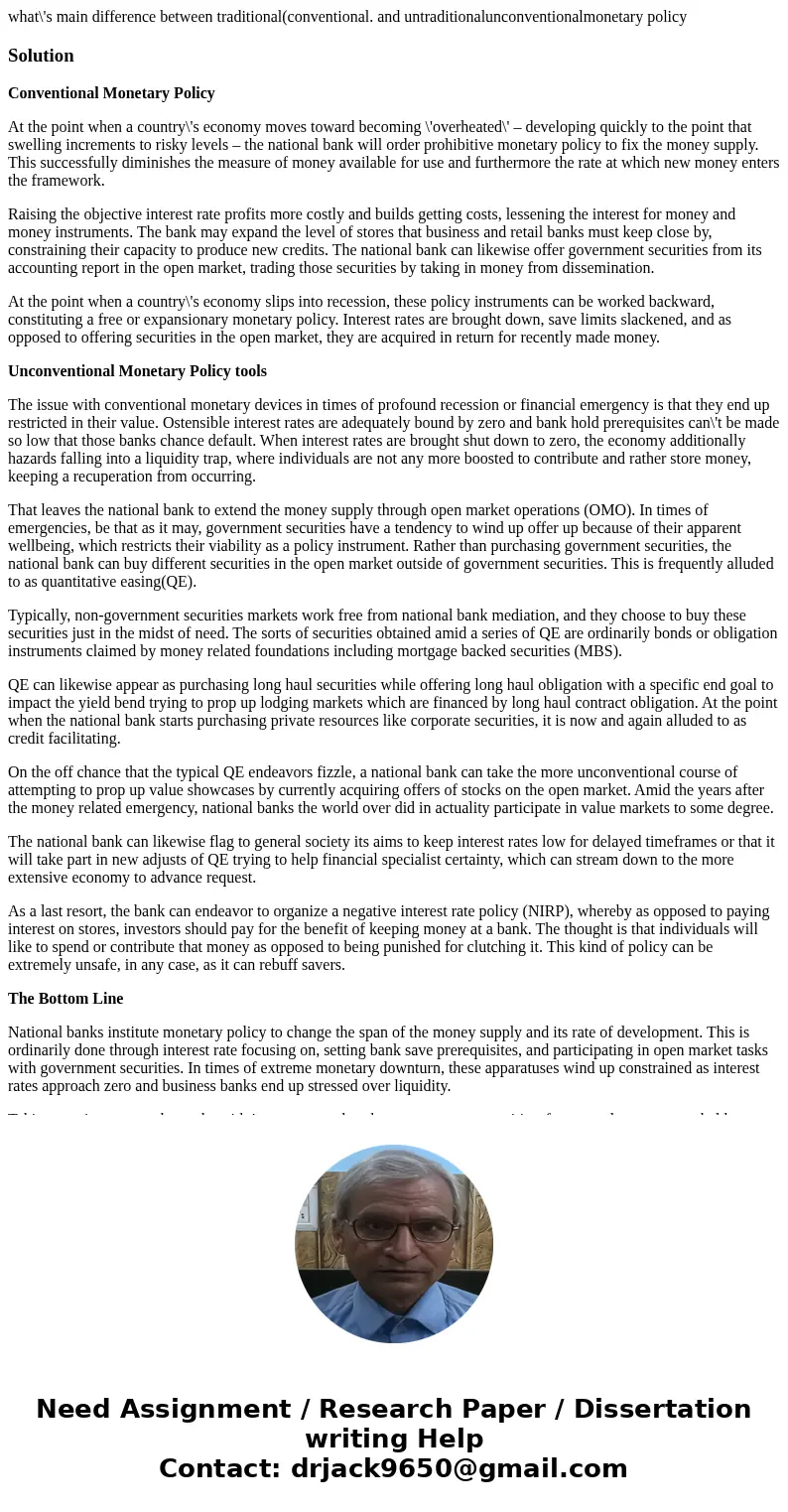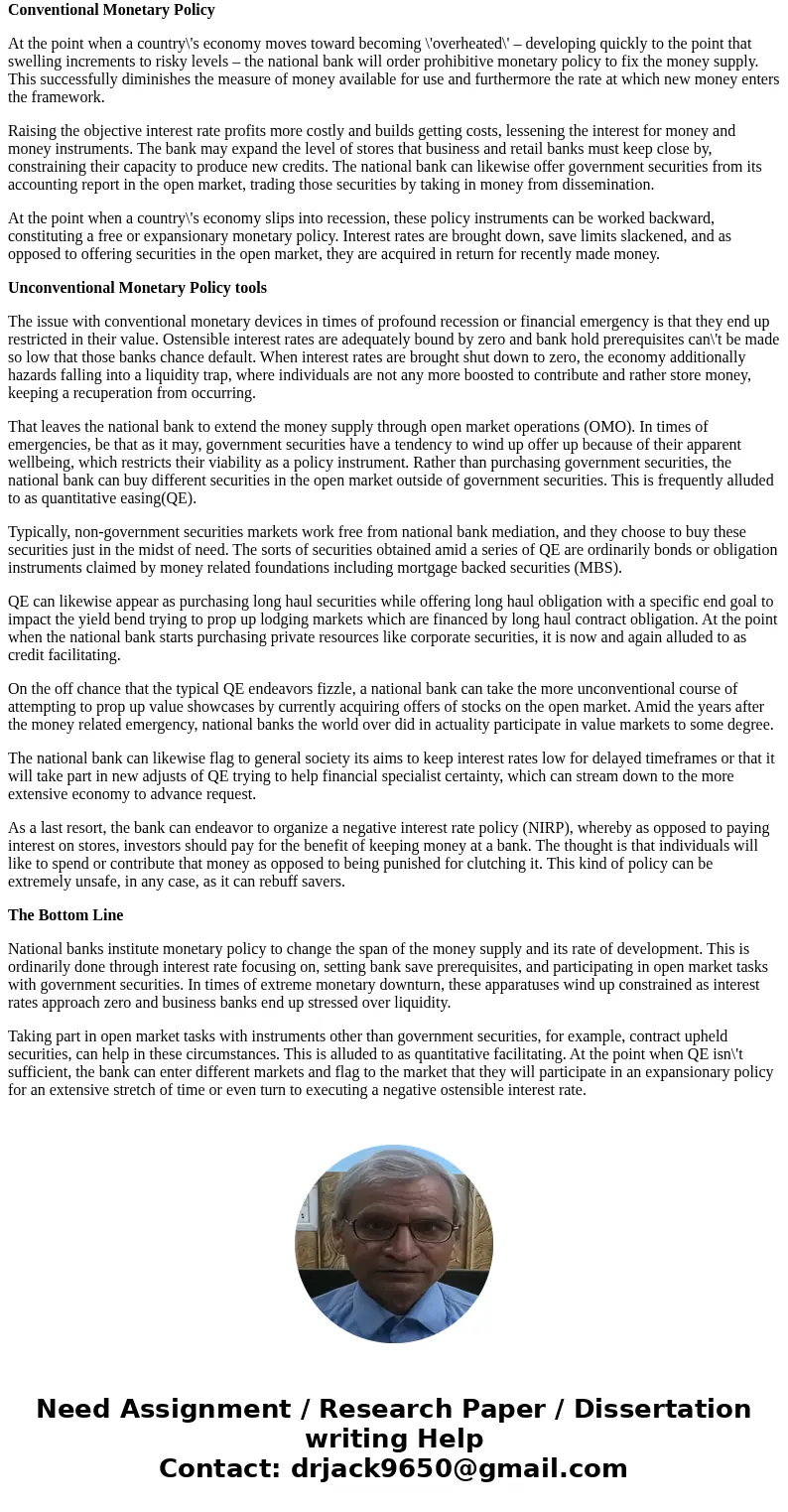whats main difference between traditionalconventional and un
what\'s main difference between traditional(conventional. and untraditionalunconventionalmonetary policy
Solution
Conventional Monetary Policy
At the point when a country\'s economy moves toward becoming \'overheated\' – developing quickly to the point that swelling increments to risky levels – the national bank will order prohibitive monetary policy to fix the money supply. This successfully diminishes the measure of money available for use and furthermore the rate at which new money enters the framework.
Raising the objective interest rate profits more costly and builds getting costs, lessening the interest for money and money instruments. The bank may expand the level of stores that business and retail banks must keep close by, constraining their capacity to produce new credits. The national bank can likewise offer government securities from its accounting report in the open market, trading those securities by taking in money from dissemination.
At the point when a country\'s economy slips into recession, these policy instruments can be worked backward, constituting a free or expansionary monetary policy. Interest rates are brought down, save limits slackened, and as opposed to offering securities in the open market, they are acquired in return for recently made money.
Unconventional Monetary Policy tools
The issue with conventional monetary devices in times of profound recession or financial emergency is that they end up restricted in their value. Ostensible interest rates are adequately bound by zero and bank hold prerequisites can\'t be made so low that those banks chance default. When interest rates are brought shut down to zero, the economy additionally hazards falling into a liquidity trap, where individuals are not any more boosted to contribute and rather store money, keeping a recuperation from occurring.
That leaves the national bank to extend the money supply through open market operations (OMO). In times of emergencies, be that as it may, government securities have a tendency to wind up offer up because of their apparent wellbeing, which restricts their viability as a policy instrument. Rather than purchasing government securities, the national bank can buy different securities in the open market outside of government securities. This is frequently alluded to as quantitative easing(QE).
Typically, non-government securities markets work free from national bank mediation, and they choose to buy these securities just in the midst of need. The sorts of securities obtained amid a series of QE are ordinarily bonds or obligation instruments claimed by money related foundations including mortgage backed securities (MBS).
QE can likewise appear as purchasing long haul securities while offering long haul obligation with a specific end goal to impact the yield bend trying to prop up lodging markets which are financed by long haul contract obligation. At the point when the national bank starts purchasing private resources like corporate securities, it is now and again alluded to as credit facilitating.
On the off chance that the typical QE endeavors fizzle, a national bank can take the more unconventional course of attempting to prop up value showcases by currently acquiring offers of stocks on the open market. Amid the years after the money related emergency, national banks the world over did in actuality participate in value markets to some degree.
The national bank can likewise flag to general society its aims to keep interest rates low for delayed timeframes or that it will take part in new adjusts of QE trying to help financial specialist certainty, which can stream down to the more extensive economy to advance request.
As a last resort, the bank can endeavor to organize a negative interest rate policy (NIRP), whereby as opposed to paying interest on stores, investors should pay for the benefit of keeping money at a bank. The thought is that individuals will like to spend or contribute that money as opposed to being punished for clutching it. This kind of policy can be extremely unsafe, in any case, as it can rebuff savers.
The Bottom Line
National banks institute monetary policy to change the span of the money supply and its rate of development. This is ordinarily done through interest rate focusing on, setting bank save prerequisites, and participating in open market tasks with government securities. In times of extreme monetary downturn, these apparatuses wind up constrained as interest rates approach zero and business banks end up stressed over liquidity.
Taking part in open market tasks with instruments other than government securities, for example, contract upheld securities, can help in these circumstances. This is alluded to as quantitative facilitating. At the point when QE isn\'t sufficient, the bank can enter different markets and flag to the market that they will participate in an expansionary policy for an extensive stretch of time or even turn to executing a negative ostensible interest rate.


 Homework Sourse
Homework Sourse